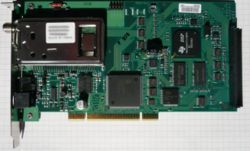Satelco Highend PCI (DVB-S): Difference between revisions
m (added link to Rev.1.3 article) |
m (Added category: DVB-S PCI Cards) |
||
| (One intermediate revision by one other user not shown) | |||
| Line 4: | Line 4: | ||
==Revisions== |
==Revisions== |
||
* [http://www.satelco.de/htm/shop/popup/highend_pci.htm rev 1.3] ... also see: [[ |
* [http://www.satelco.de/htm/shop/popup/highend_pci.htm rev 1.3] ... also see: [[FF Rev. 1.3 DVB-S Cards]] |
||
* rev 2.3 (as seen in the image above) ... |
* rev 2.3 (as seen in the image above) ... |
||
| Line 119: | Line 119: | ||
==External Links== |
==External Links== |
||
* [http://www.satelco.de/htm/shop/satellit_dvb_s/index.htm Satelco website] |
* [http://www.satelco.de/htm/shop/satellit_dvb_s/index.htm Satelco website] |
||
[[Category:DVB-S PCI Cards]] |
|||
Latest revision as of 20:38, 4 May 2009
A DVB-S PCI card from Satelco.
Revisions
- rev 1.3 ... also see: FF Rev. 1.3 DVB-S Cards
- rev 2.3 (as seen in the image above) ...
Installation
Card drivers will be automatically detected and loaded by most linux distributions (e.g. Kubuntu). You need just to ensure that the firmware file "dvb-ttpci-01.fw" is installed in "/lib/firmware".
Remote Control (revision 2.3)
You need to load the description file for the remote control used.
av7110_loadkeys /etc/dvb-rc/satelco-highend.rc5 >/proc/av7110_ir
A script should be added to /etc/init.d which executes the command above. Then it need to be added to the runlevel directory.
Description file "satelco-highend.rc5"
0x27 KEY_SETUP 0x1a KEY_AUDIO 0x01 KEY_POWER 0x21 KEY_OPTION 0x12 KEY_MENU 0x22 KEY_EPG 0x14 KEY_RED 0x13 KEY_EXIT 0x15 KEY_GREEN 0x16 KEY_YELLOW 0x17 KEY_BLUE 0x0e KEY_LEFT 0x0d KEY_UP 0x10 KEY_RIGHT 0x11 KEY_DOWN 0x0f KEY_OK 0x19 KEY_TEXT 0x23 KEY_CHANNELUP 0x24 KEY_CHANNELDOWN 0x25 KEY_VOLUMEUP 0x26 KEY_VOLUMEDOWN 0x03 KEY_1 0x04 KEY_2 0x05 KEY_3 0x06 KEY_4 0x07 KEY_5 0x08 KEY_6 0x09 KEY_7 0x0a KEY_8 0x0b KEY_9 0x0c KEY_0 0x02 KEY_BACK 0x18 KEY_MUTE
VDR
The easiest way to use vdr with the remote control is the vdr-remote plugin. You can add the following paramater to your runvdr script in the line where vdr is started:
IRDEV="`/usr/local/bin/getIRRReceiver.pl`" vdr -P "remote -i $IRDEV"
The following command will return a list with input devices:
cat /proc/bus/input/devices I: Bus=0001 Vendor=13c2 Product=000e Version=0002 N: Name="DVB on-card IR receiver" P: Phys=pci-0000:00:07.0/ir0 S: Sysfs=/class/input/input2 H: Handlers=kbd event2I: Bus=0001 Vendor=13c2 Product=000e Version=0002 N: Name="DVB on-card IR receiver" P: Phys=pci-0000:00:07.0/ir0 S: Sysfs=/class/input/input2 H: Handlers=kbd event2 B: EV=100013 B: KEY=1 ffffffff ffffffff ffffffff ffffffff ffffffff ffffffff ffffffff fffffffe B: MSC=18 B: EV=100013 B: KEY=1 ffffffff ffffffff ffffffff ffffffff ffffffff ffffffff ffffffff fffffffe B: MSC=18
In this example the IR is on "/dev/input/event2". The script "getIRRReceiver.pl" automatically detects this and environment variable "IRDEV" is set accrodingly in the above example.
Script "getIRRReceiver.pl"
#!/usr/bin/perl
#
# Find /dev/input/eventXX device used by DVB on-card IR receiver.
#
use strict;
my %device;
my $deviceNr = 0;
open(FIN, "<", "/proc/bus/input/devices") or die "Failed to open file";
while(<FIN>)
{
s/\n//g;
s/\r//g;
if (/=/) {
my ($name, $value) = split(/=/);
$device{$name} = $value;
} else {
if ($device{"N: Name"} eq "\"DVB on-card IR receiver\"") {
if ($device{"H: Handlers"} =~ /event([0-9]*)/) {
$deviceNr = $1;
}
}
}
}
close(FIN);
printf("/dev/input/event%d\n", $deviceNr);
